People have grown taller over the last century, with South Korean women shooting up by more than 20cm on average, and Iranian men gaining 16.5cm. A global study looked at the average height of 18-year-olds in 200 countries between 1914 and 2014.
The results reveal that while Swedes were the tallest people in the world in 1914, Dutch men have risen from 12th place to claim top spot with an average height of 182.5cm. Latvian women, meanwhile, rose from 28th place in 1914 to become the tallest in the world a century later, with an average height of 169.8cm.
James Bentham, a co-author of the research from Imperial College, London, says the global trend is likely to be due primarily to improvements in nutrition and healthcare. "An individual's genetics has a big influence on their height, but once you average over whole populations, genetics plays e less key role," he added.
A little extra height brings a number of advantages, says Elio Riboli of Imperial College. "Being taller is associated with longer life expectancy," he said. "This is largely due to a lower risk of dying of cardiovascular (心血管的)disease among taller people."
But while height has increased around the world, the trend in many countries of north and sub-Saharan Africa causes concern, says Riboli. While height increased in Uganda and Niger during the early 20th century, the trend has reversed in recent years, with height decreasing among 18-year-olds.
"One reason for these decreases in height is the economic situation in the 1980s," said Alexander Moradi of the University of Sussex. The nutritional and health crises that followed the policy of structural adjustment, he says, led to many children and teenagers failing to reach their full potential in terms of height.
Bentham believes the global trend of increasing height has important implications. "How tall we are now is strongly influenced by the environment we grew up in," he said. "If we give children the best possible start in life now, they will be healthier and more productive for decades to come."
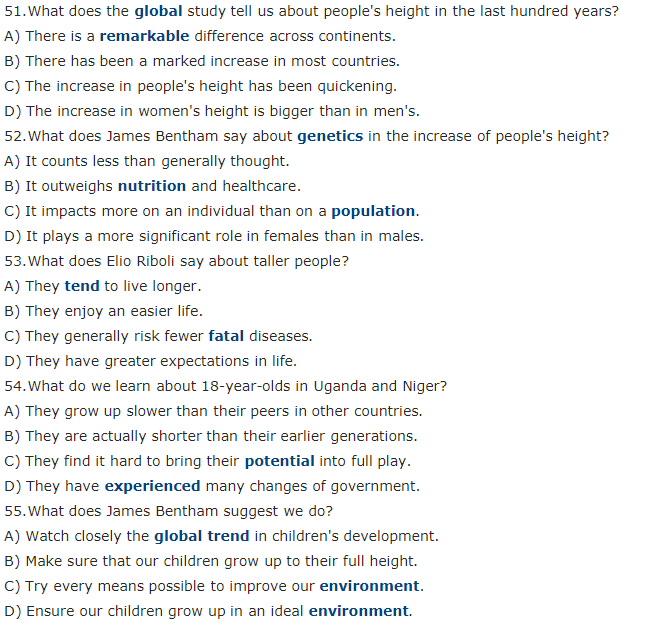
正确答案及解析
正确答案
BCABD
解析
上个世纪人们长高了,韩国女性平均身高增加了 20 厘米以上,伊朗男性增加了 16.5 厘米。一项全球研究调查了 1914 年至 2014 年间 200 个国家/地区 18 岁青少年的平均身高。
结果显示,虽然瑞典人在 1914 年是世界上最高的人,但荷兰男性已经从第 12 位上升到平均身高 182.5 厘米的榜首。与此同时,拉脱维亚女性从 1914 年的第 28 位上升到一个世纪后成为世界上最高的女性,平均身高为 169.8 厘米。
伦敦帝国理工学院研究的合著者 James Bentham 表示,全球趋势可能主要是由于营养和医疗保健的改善。“一个人的基因对他们的身高有很大的影响,但是一旦你对整个人群进行平均,基因的作用就不那么重要了,”他补充道。
帝国理工学院的 Elio Riboli 说,稍微高一点会带来很多好处。“更高与更长的预期寿命有关,”他说。“这主要是由于较高的人死于心血管(心血管)疾病的风险较低。”
Riboli 说,虽然世界各地的身高都在增加,但北非和撒哈拉以南非洲许多国家的这一趋势令人担忧。虽然 20 世纪初乌干达和尼日尔的身高有所增加,但近年来这一趋势发生了逆转,18 岁儿童的身高有所下降。
“身高下降的一个原因是 1980 年代的经济形势,”萨塞克斯大学的亚历山大莫拉迪说。他说,结构调整政策带来的营养和健康危机导致许多儿童和青少年未能在身高方面充分发挥潜力。
Bentham 认为,全球身高增长趋势具有重要意义。“我们现在的身高受到我们成长环境的强烈影响,”他说。“如果我们现在就给孩子们最好的人生开端,他们将在未来几十年变得更健康、更有效率。”
你可能感兴趣的试题
Textbooks represent an 11 billion dollar industry, up from $8 billion in 2014. Textbook publisher Pearson is the largest publisher -- of any kind -- in the world.
It costs about $1 million to create a new textbook. A freshman textbook will have dozens of contributors, from subject-matter experts through graphic and layout artists to expert reviewers and classroom testers. Textbook publishers connect professors, instructors and students in ways that alternatives, such as open e-textbooks and open educational resources, simply do not. This connection happens not only by means of collaborative development, review and testing, but also at conferences where faculty regularly decide on their textbooks and curricula for the coming year.
It is true that textbook publishers have recently reported losses, largely due to students renting or buying used print textbooks. But this can be chalked up to the excessively high cost of their books -- which has increased over 1,000 percent since 1977. A restructuring of the textbook industry may well be in order. But this does not mean the end of the textbook itself.
While they may not be as dynamic as an iPad, textbooks are not passive or lifeless. For example, over the centuries, they have simulated (模拟) dialogues in a number of ways. From 1800 to the present day, textbooks have done this by posing questions for students to answer inductively (归纳性地). That means students are asked to use their individual experience to come up with answers to general questions. Today's psychology texts, for example, ask: "How much of your personality do you think you inherited?" while ones in physics say: "How can you predict where the ball you tossed will land?"
Experts observe that "textbooks come in layers, something like an onion." For an active learner, engaging with a textbook can be an interactive experience. Readers proceed at their own pace. They "customize" their books by engaging with different layers and linkages. Highlighting, Post-It notes, dog-ears and other techniques allow for further customization that students value in print books over digital forms of books.
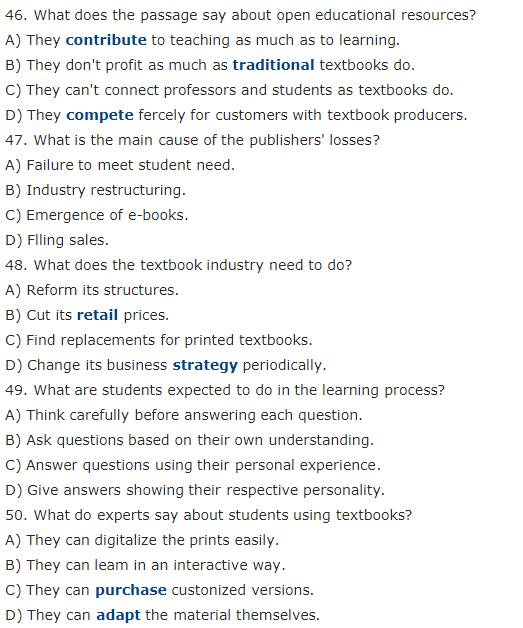
- 查看答案
When we think of animals and plants, we have a pretty good way of dividing them into two distinct groups: one converts sunlight into energy and the other has to eat food to make its energy. Well, those dividing lines come crashing down with the discovery of a sea slug (海蛞蝓) that's truly half animal and half plant. It's pretty incredible how it has managed to hijack the genes of the algae (藻类) on which it feeds.
The slugs can manufacture chlorophyll, the green pigment (色素) in plants that captures energy from sunlight, and hold these genes within their body. The term kleptoplasty is used to describe the practice of using hijacked genes to create nutrients from sunlight. And so far, this green sea slug is the only known animal that can be truly considered solar-powered, although some animals do exhibit some plant-like behaviors. Many scientists have studied the green sea slugs to confirm that they are actually able to create energy from sunlight.
In fact, the slugs use the genetic material so well that they pass it on to their future generations. Their babies retain the ability to produce their own chlorophyll, though they can't generate energy from sunlight until they've eaten enough algae to steal the necessary genes, which they can't yet produce on their own.
"There's no way on earth that genes from an alga should work inside an animal cell," says Sidney Pierce from the University of South Florida. "And yet here, they do. They allow the animal to rely on sunshine for its nutrition. So if something happens to their food source, they have a way of not starving to death until they find more algae to eat."
The sea slugs are so good at gathering energy from the sun that they can live up to nine months without having to eat any food. They get all their nutritional needs met by the genes that they've hijacked from the algae.
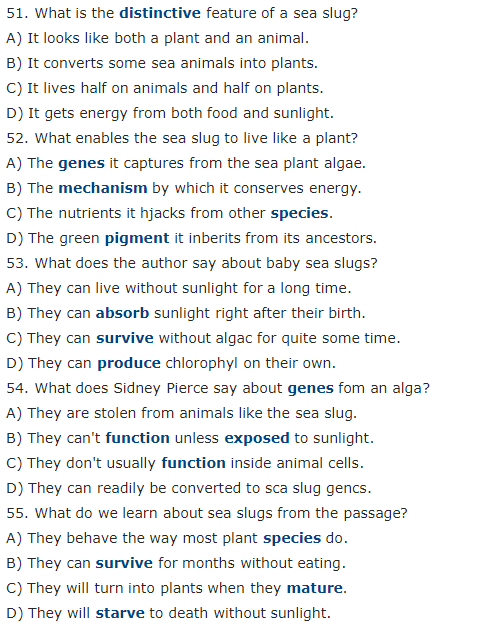
- 查看答案
For this part, you are allowed 30 minutes to write a letter to a foreign friend who wants to teach English in China. Please recommend a city to him. You should write at least 120 words but no more than 180 words.
- 查看答案
A) We've always been a hands-on, do it-yourself kind of nation. Ben Franklin, one of America's founding fathers, didn't just invent the lightning rod. His creations include glasses, innovative stoves and more.
B) Franklin, who was largely self-taught, may have been a genius, but he wasn't really an exception when it comes to American making and creativity.
C) The personal computing revolution and philosophy of disruptive innovation of Silicon Valley grew, in part, out of the creations of the Homebrew Computer Club, which was founded in a garage in Menlo Park, California, in the mid-1970s. Members-including guys named Jobs and Wozniak-started making and inventing things they couldn't buy.
D) So it's no surprise that the Maker Movement today is thriving in communities and some schools across America. Making is available to ordinary people who aren't tied to big companies, big defense labs or research universities. The maker philosophy echoes old ideas advocated by John Dewey, Montessori, and even ancient Greek philosophers, as we pointed out recently.
E) These maker spaces are often outside of classrooms, and are serving an important educational function. The Maker Movement is rediscovering learning by doing, which is Dewey's phrase from 100 years ago. We are rediscovering Dewey and Montessori and a lot of the practices that they pioneered that have been forgotten or at least put aside. A maker space is a place which can be in a school, but it doesn't look like a classroom. It can be in a library. It can be out in the community. It has tools and materials. It's a place where you get to make things based on your interest and on what you, re learning to do.
F) Ideas about learning by doing have struggled to become mainstream educationally, despite being old concepts from Dewey and Montessori, Plato and Aristotle, and in the American context, Ralph Emerson, on the value of experience and self-reliance. It's not necessarily an efficient way to learn. We learn, in a sense, by trial and error. Learning from experience is something that takes time and patience. It's very individualized. If your goal is to have standardized approaches to learning, where everybody learns the same thing at the same time in the same way, then learning by doing doesn't really fit that mold anymore. It's not the world of textbooks. It's not the world of testing.
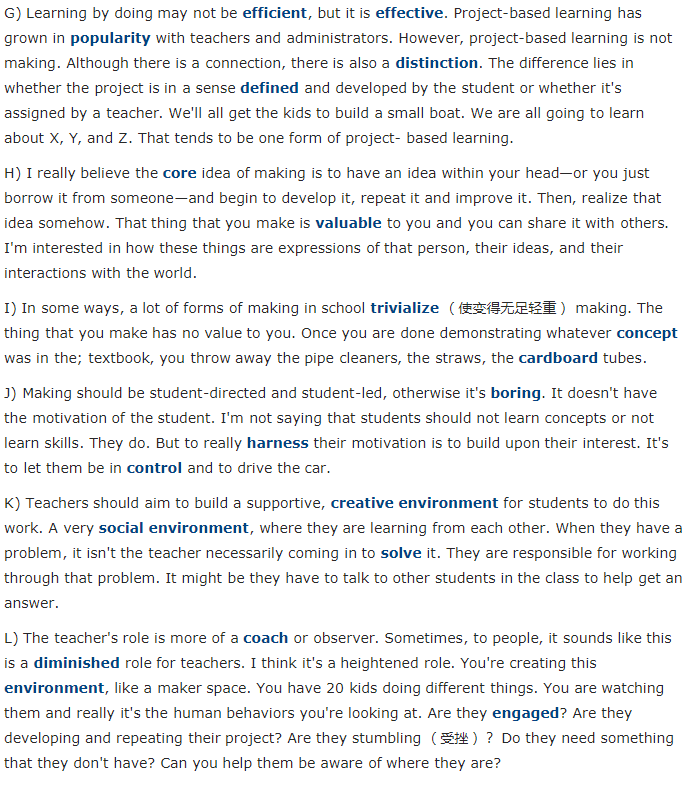
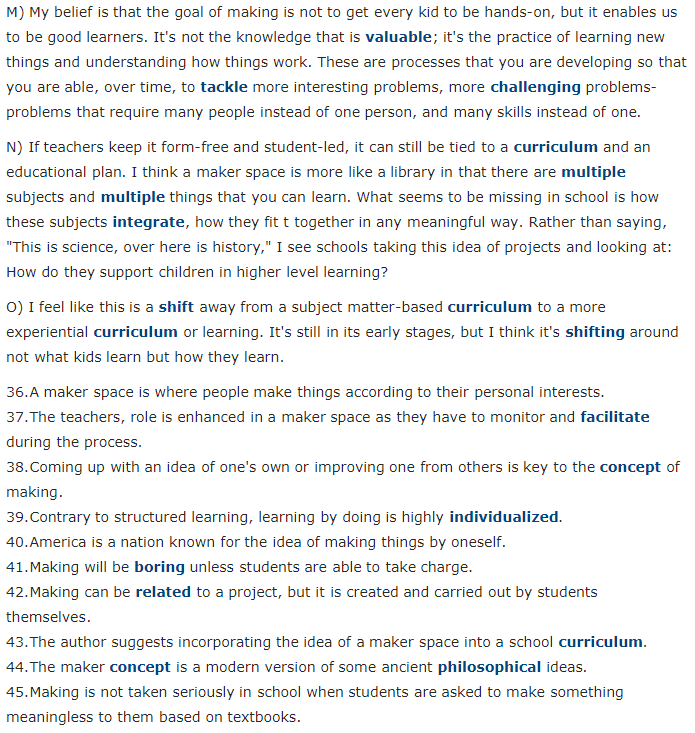
- 查看答案
Professor Ashok Goel of Georgia Tech developed an artificially intelligent teaching assistant to help handle the enormous number of student questions in the online class, Knowledge-Based Artificial Intelligence. This online course is a core requirement of Georgia Tech's online Master of Science in Computer Science program. Professor Goel already had eight teaching assistants, but that wasn't enough to deal with the overwhelming number of daily questions from students.
Many students drop out of online courses because of the lack of teaching support. When students feel isolated or confused and reach out with questions that go unanswered, their motivation to continue begins to fade. Professor Goel decided to do something to remedy this situation and his solution was to create a virtual assistant named Jill Watson, which is based on the IBM Watson platform.
Goel and his team developed several versions of Jill Watson before releasing her to the online forums. At first, the virtual assistant wasn't too great. But Goel and his team sourced the online discussion forum to find all the 40,000 questions that had ever been asked since the class was launched. Then they began to feed Jill with the questions and answers. After some adjustments and sufficient time, Jill was able to answer the students' questions correctly 97% of the time. The virtual assistant became so advanced and realistic that the students didn't know she was a computer. The students, who were studying artificial intelligence, were interacting with the virtual assistant and couldn't tell it apart from a real human being. Goel didn't inform them about Jill's true identity until April 26. The students were actually very positive about the experience.
The goal of Professor Goel's virtual assistant next year is to take over answering 40% of all the questions posed by students on the online forum. The name Jill Watson will, of course, change to something else next semester. Professor Goel has a much rosier outlook on the future of artificial intelligence than, say, Elon Musk, Stephen Hawking, Bill Gates or Steve Wozniak.
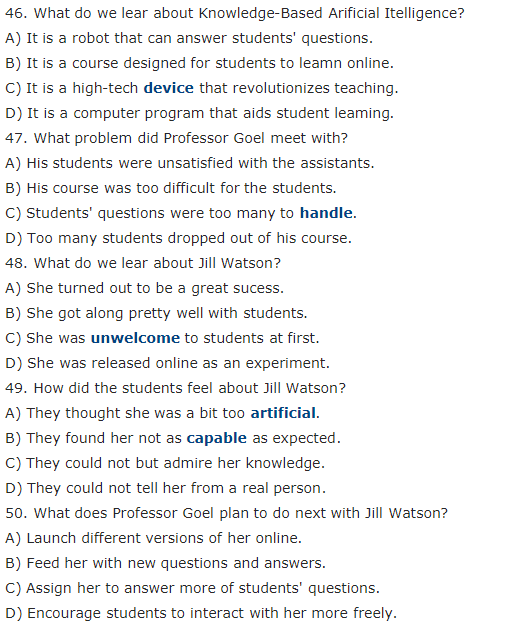
- 查看答案